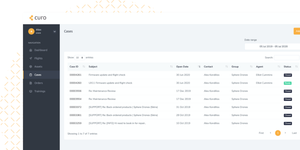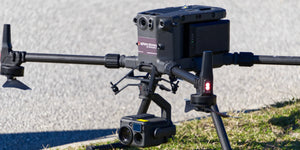DJI’s Phantom 4 RTK is considered an industry benchmark in regard to what you ‘get out for the money you put in’. Now a proven low altitude mapping solution, the Phantom 4 RTK enjoys remarkable on-board technology for its size and is considered a genuine commercial enterprise solution.
The DJI Mavic 2 Enterprise is also considered an enterprise-centred drone providing imaging abilities far beyond those simply needed for the recreational shooting of still images and video.
As a world leader in both civilian drones and aerial imaging technology, DJI is considered highly proactive in the engagement of technology features (relative to cost) in both its range of commercial and consumer drones.
A line in the sand
With the commercial UAV market growing at an exponential rate and with forecast global revenues anticipated to top more than US$20 billion (yep, billion) by 2022, there is little doubt drone manufacturers are focussed on a desire to see their drones offering greater commercial opportunities and value for their clients across all drone price points.
Cleary those that offer ‘more’ in the way of clients being able to secure a return on their investment will benefit from increased awareness, brand loyalty and on-going sales.
This noted, let's look at these two DJI drones and what they offer a commercial application.
DJI Phantom 4 RTK
The Phantom 4 RTK has evolved to meet the specific needs of users who now actively engage this UAV solution for their surveying and mapping operations.
DJI notes this ‘evolvement’ happened not simply by osmosis, but via an active market engagement process where feedback was considered and implemented in the 4 RTK to make it a truly segment focussed commercial offering.
What technology is on offer in the 4 RTK?
RTK
As the name suggests, an RTK module is integrated directly into the drone, providing real-time, centimeter-level positioning data for improved absolute accuracy on image metadata. For the record, a non-RTK drone can require up to 40 ground control points (GCP) per square kilometre which can take hours to place. The DJI Phantom 4 RTK’s in-built centimetre-accurate RTK navigation positioning system and a high-performance imaging system - makes it commercially viable for small-to medium (organisation) mapping requirements.
Safer, smarter and more stable flight
The Phantom 4 RTK has a commercial grade video transmission system that enables a stable connection between the drone and its remote controller. The system features strong interference resistance and delivers impressive 720p video transmission feeds (well beyond those need by recreational users) and at a distance of up to 7 km, which is ideal for mapping larger sites.
It also enjoys a flight time of up to 30 minutes allowing pilots to complete longer missions without having to land the drone to change batteries. Even if the area is too large to map on a single battery charge, the Operation Resumption function of the RTK automatically resumes the mission after the battery has been replaced.
Precise imaging
The 4 RTK drone is also equipped with a commercial grade 1” 20 megapixel CMOS sensor. The mechanical shutter makes mapping missions or regular data capture seamless as the Phantom 4 RTK can move while taking pictures without the risk of rolling shutter blur. Due to the high resolution, the Phantom 4 RTK can achieve a Ground Sample Distance (GSD) of 2.74 cm at 100 meters flight altitude.
Overall
The Phantom 4 RTK is clearly a UAV solution that moves beyond simple recreational activities. Equipped to conduct professional mapping and surveying operations, it is a true enterprise drone that will provide its users with a genuine business tool.
DJI Mavic 2 Enterprise
The Mavic has also undergone a number of iterations in its move along the commercial track. Now clearly designed for users that want more than ‘aerial fun,’ it has come of age as a true enterprise offering for those that seek commercial outcomes at a reasonable entry cost.
What technology is on offer in the Mavic 2 Enterprise?
Recently unveiled, the Mavic 2 Enterprise is a prime example of development iteration from fun to functional. The new Mavic while (still) portable in stature and nature, is now targeted and indeed actively engaged in critical and rapid response operations from firefighting, emergency response, law enforcement and infrastructure inspections.
Imaging
The Mavic 2 Enterprise uses a 1/2.3” 12 Megapixel CMOS sensor that is stabilised by a three-axis gimbal - ideal for secure imaging in challenging situations. The camera also has a 2x optical and 3x digital zoom capability. This zoom technology gives the drone the ability to identify and inspect dangerous or difficult areas, as well as to help emergency services protect life and property. The camera can capture 4K video at up to 30 fps.
Tools
What makes the Mavic 2 Enterprise even more commercially attractive is the new DJI accessories that can be securely mounted to the drone’s body and operated via the flight control app. These accessories are primarily for emergency response and law enforcement and play a major part in a disaster or event. They include:
M2E spotlight: A dual spotlight with a brightness of 2,400 lumens to aid operators in carrying out missions in dark or low-light areas. The spotlight is ideal for search and rescue as well as inspection applications.
M2E speaker: A loudspeaker with a maximum projection of 100 decibels (1-metre distance) lets pilots play up to 10 custom voice recordings on demand, providing a communications channel to nearby individuals that can be critical during lifesaving emergency operations.
M2E beacon: Designed to (FAA) standards, the M2E beacon features a bright flashing strobe visible 5km away. This helps pilots carry out missions in low-light conditions or at night much more safely, and provides additional airspace awareness for operators of nearby drones and traditional aircraft.
Overall
As with the Phantom 4 RTK, the Mavic 2 Enterprise is clearly destined for commercial applications. It has price point that will be attractive to smaller commercial users who will then benefit from DJI’s leading UAV and payload combinations. As with the Phantom 4 RTK, we rate the Mavic 2 Enterprise as a true business tool.
About Sphere Drones
Sphere Drones is a leading Australian provider of comprehensive UAV products and application solutions for the commercial market. Proudly Australian-owned and an operating entity since 1954, their end-to-end system solutions create outcomes that are highly-functional, cost-effective and, most importantly, commercially successful. Carrying the world’s best UAV brands and accessories, their Sydney-based headquarters operates as research and development (R&D) facility, allowing existing and prospective clients to work in tandem with the Sphere Drones team to create custom and often proprietary commercial UAV solutions.



















